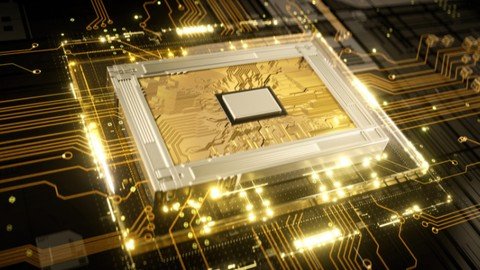
Published 4/2024
MP4 | Video: h264, 1920×1080 | Audio: AAC, 44.1 KHz
Language: English | Size: 7.97 GB | Duration: 13h 22m
Unlock the Potential of ARM: Mastering Architecture, Programming, and Optimization for Next-Generation Embedded Systems
What you’ll learn
Comprehensive Understanding of ARM Architecture
Advanced System Concepts like MMU and TCM
AMBA Architecture and System Integration
Serial Communication Protocols
ARM Data Formats, Directives & Addressing Modes
ARM7 Assembly Instructions
Assembly and C Programming
Requirements
No Prior knowledge is needed. You will learn step by step from basic.
Basic C programming skill will be an added advantage in programming section.
Description
This ARM Microprocessor course is an advanced processor course, specially designed for engineering students who want to enter the field of Embedded systems and is also helpful for working professionals. This is a unique course in the online marketplace.This ARM Processor core has been widely used in many application areas such as Mobile, PC, Laptop, Printer, Automobile, and many more. It is considered the most advanced architecture due to its high performance, less power consumption, and long life.After understanding this ARM Microprocessor, especially ARM7 in this course, it will be the stepping stone to understanding some advanced architectures such as ARM9, Cortex A, Cortex M and Cortex R, etc.This course covers the theory and programming of ARM7-based LPC2148 microcontroller, both in assembly and C, and some software tools needed for programming.This course covers the following topics.- History and Cores of ARM- Features of ARM- RISC, CISC, Harvard, and Von Neumann Architecture- ARM7 Architecture/Data Flow Model- ARM and Thumb State- ARM7 Operating Modes and Programming Model- ARM7 Interrupts- AMBA Architecture- Paging and MMU concepts of ARM- Buffer, Cache, TCM Concept- SPI/I2C and UART Protocols- Addressing Modes of ARM7- Assembly Instructions of ARM7- Assembly and C Programming of ARM 7I have covered this entire course in a simple English language so that majority of students can easily follow it.So, go through this entire course step by step and I am pretty sure that you will get thorough knowledge about this most advanced ARM Processor.All the best…
Overview
Section 1: Introduction to Course
Lecture 1 Introduction
Section 2: Introduction to ARM Processor
Lecture 2 Development History of ARM
Lecture 3 ARM IP Core
Lecture 4 Comaparison of Coretex A, M & R
Lecture 5 Features of ARM Processor
Lecture 6 RISC Design Philosophy
Lecture 7 RISC Vs CISC
Lecture 8 Von Neumann Vs Harvard
Lecture 9 Little Endian & Big Endian
Section 3: ARM7 Processor Basics
Lecture 10 ARM7 Data Types
Lecture 11 ARM7 Architecture
Lecture 12 CPSR of ARM7
Lecture 13 ARM State Vs Thumb State
Lecture 14 ARM7 Operating Modes
Lecture 15 ARM7 Programming Model
Lecture 16 ARM7 Pipelining
Lecture 17 ARM7 Interrupt
Lecture 18 Memory with ARM7
Lecture 19 AMBA
Lecture 20 Paging in ARM
Lecture 21 TLB & MMU in ARM
Lecture 22 MMU Advantages
Section 4: Memory Structure in Processor
Lecture 23 Cache Memory
Lecture 24 Buffer Vs Cache
Lecture 25 TCM Vs Cache
Section 5: Serial Communication Protocols
Lecture 26 I2C Protocol
Lecture 27 SPI Protocol
Lecture 28 I2C Vs SPI Protocol
Lecture 29 UART
Lecture 30 USB
Lecture 31 RS 232
Section 6: Basic of Programming in Processor
Lecture 32 Assembly Vs C
Lecture 33 Optimization of Embedded C Programming
Lecture 34 ARM Development Tools
Section 7: ARM Data formats, Directives & Addressing Modes
Lecture 35 ARM Data Types
Lecture 36 ARM Assembler Directives
Lecture 37 Addressing Modes of ARM7
Section 8: ARM 7 Instructions
Lecture 38 Conditional Instructions
Lecture 39 Data Transfer Instructions
Lecture 40 Load & Store Instructions
Lecture 41 Arithmatic Instructions
Lecture 42 Multiplication Instructions
Lecture 43 Logical Instructions
Lecture 44 Stack Instructions
Lecture 45 Flag Instructions
Lecture 46 Special Instructions
Lecture 47 Semaphore Instructions
Lecture 48 How to use Instructions in ARM7
Section 9: Assembly Programming
Lecture 49 Keil Installation Guide
Lecture 50 Keil Introduction for ARM7
Lecture 51 Data Transfer
Lecture 52 Array Addition
Lecture 53 Factorial
Lecture 54 Expression Evaluation
Lecture 55 Largest
Lecture 56 EvenOdd
Lecture 57 Bitwise Logical
Lecture 58 DectoHex
Lecture 59 P11 Hext to Dec
Section 10: LPC 2148 C Programming
Lecture 60 LPC2148 Features
Lecture 61 LED blinking
Lecture 62 SW LED
Lecture 63 7 Segment Interfacing
Lecture 64 LCD Interfacing
Lecture 65 PLL
Lecture 66 Timer
Lecture 67 Serial TX
Lecture 68 Serial RX
Section 11: Important Basic Microprocessor and Microcontroller Questions
Lecture 69 MP and MC Questions
Embedded Systems Engineers,Software Developers,Hardware Engineers,Students (Engineering, Diploma, Science),Tech Enthusiasts
Password/解压密码www.tbtos.com